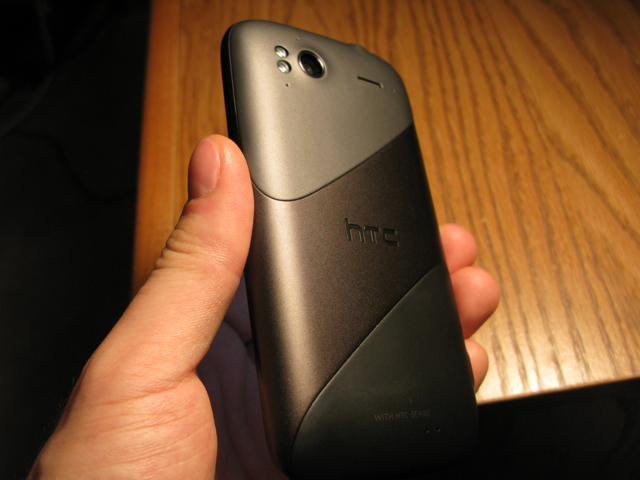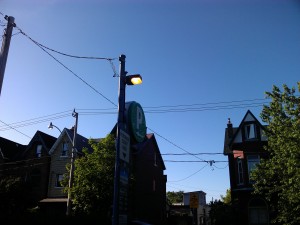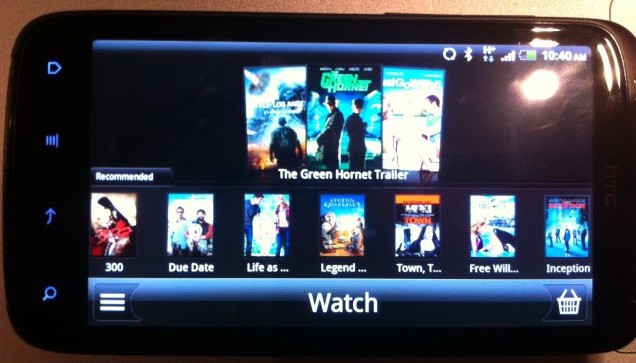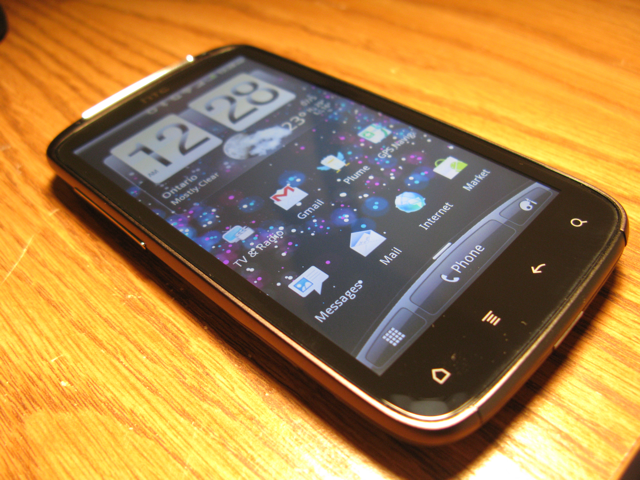
These days, I feel like I spend a lot of time reviewing HTC devices. Recently, I have taken a look at the Incredible S, Panache, Wildfire S, among others, and each time I am left with the indelible impression that we are witnessing a company at the height of its design prowess and software convergence. Being able to mould into a cohesive product such a fragmented operating system as Android is HTC’s definable quality, and that they’ve improved on (for the most part) each previous generation of phone is a notable distinction.
The HTC Sensation 4G is another leap in their quest to corner the market with their distinctive metallic tones and unibody architecture, and for the most part it succeeds. Combining a dual-core Snapdragon processor with a healthy display resolution and plenty of improvements to their Sense overlay, the Sensation could just be the best Android phone they’ve ever released. Can it compete, though, with similar offerings from Samsung, LG, Motorola and Sony Ericsson? Read on to find out.
Specs
– Android 2.3.3 Gingerbread w/ Sense 3.0
– 960×540 qHD LCD display
– 1.2Ghz dual-core Snapdragon MSM8260 processor w/ Adreno 220 GPU
– 768MB RAM / 1GB internal storage
– 8MP camera with dual LED flash / VGA front camera
– 1080p video capture / playback via MHL-HDMI out
– WiFi b/g/n, Bluetooth 3.0, A-GPS
– DLNA support (with included app)
– HSDPA 14.4 Mbps, HSUPA 5.76 Mbps
– FM Radio/ Flashlight support
– 1520mAh battery
– 148g
– 126.1 x 65.4 x 11.3 mm
– 850/1900Mhz UMTS (3G), 850/900/1900/2100Mhz EDGE (4G)
The Phone: A Design Monster
HTC practically owns unibody. From the HTC Legend to the Desire HD, the fundamentals of forging an exoskeleton from a single piece of metal, usually aluminum, is not a new one. Over time they have identified the various strengths and liabilities of the design, and the Sensation feels like a happy medium. Whereas the Desire HD had a battery latch that inspired, when removed, more grunting than a female tennis match, the Sensation’s back cover is more traditional in many ways, while retaining the structural integrity of its unibody forebears.
Loosened by a small latch on the bottom, the battery cover extends to part of the front and side of the device, leaving it looking rather cyborg-like in its natural state. More than just tri-tone eye candy, it also contains, on the inside, like a gold tooth, the pinpoints for the various antennas. Removing the back means losing your signal.
The rest of the device is standard HTC fare: a left-sided volume rocker, nice and clicky, and below it a dual microUSB/HDMI port (called MHL) we first saw in the Sony Ericsson Xperia arc and lately in the Samsung Galaxy S II. Though an adapter is needed to connect it to an HD television (around $40CAD) it helps keep production costs down.
Due to the unibody construction, the device is thin (though at 11.3mm, some 2.6mm thicker than the Galaxy S II), and feels phenomenal to hold. Easily the most rigidly-built Android phone to date, the qHD resolution screen means that it is taller and narrower than traditional Android devices at 960×540 vs their 800×480. The aspect ratio is different, too, at 16:9 vs 5:3. While wider resolutions offer more horizontal space for reading, the LCD screen on the Sensation offers sharper text and increased viewing space. This comes with some compromises, however…
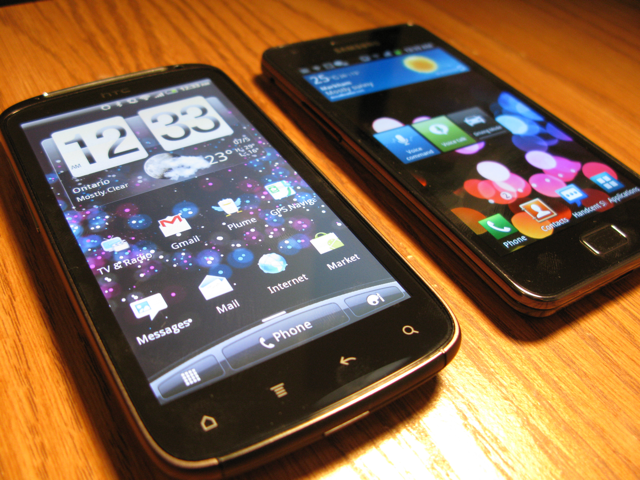
Display
The display on the Sensation is good, but not great. Perhaps I have been spoiled by its nearest competitor, the Samsung Galaxy S II. Colours sit on the surface like wet paint, while images feel far away, lodged somewhere beneath the concave screen. Despite having some 400nits of backlight, the screen washes out at narrow angles. Greens and blues are darker than they should be, and blacks have a tinge of gray.
I often tell people the reason I so love the Incredible S is for its Super LCD screen, and how effortlessly it reacts to every touch of my finger. This cannot be said for the Sensation. As generally smooth as it is, there is something not quite right about Sense 3.0. Perhaps it is the faux 3D effects HTC attempted to build into the framework, or the artistic flourishes that come off as half-hearted, but call me sentimental: I just want my flat, colourful Sense 2.1 back.
There are a few, ahem, bright spots in the mix. White levels are indeed excellent, and as a result reading text on the Sensation’s slightly inwardly curved screen is a pleasure. So too is browsing, as the extra pixels lend themselves nicely to formatting on the generally-speedy browser.
And because the max brightness level is quite good, the Sensation is more viewable in direct sunlight than most Android phones, even though in such conditions blacks look like a mix of yellow and gray.
Most devices wouldn’t call attention to the display in any other way than it performs but the Sensation’s Gorilla Glass is slightly concave, about a millimetre, from edge to edge. Similar to the Nexus S, it is supposed to allow for smoother finger movement, and is said to improve readability of text. Neither of these aspects were particularly better than a completely flat display, but where it may help most is in protecting the device: laying it display-down means that the majority of the glass does not touch the surface on which it is placed.
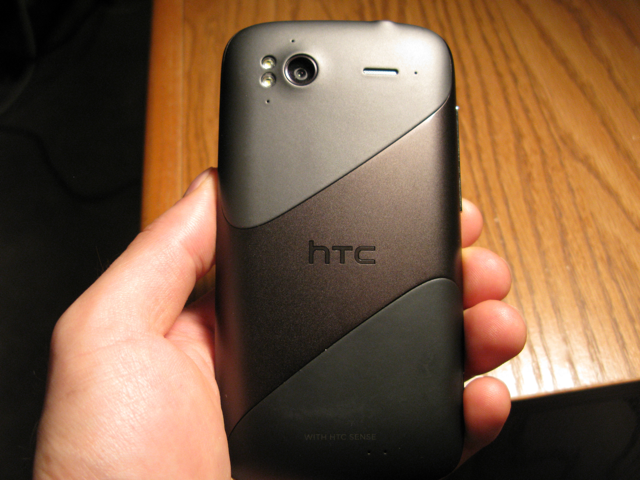
Performance
Much can be said about the introduction of dual-core into the world of Android smartphones. Surely a logical progression, some would say it has introduced more problems than it’s solved (see battery life below).
Rest assured, however, that the Sensation has mostly benefited from the included Snapdragon MSM8260 processor, which, at 1.2Ghz, can only be described as randy. Animations are smooth throughout the OS, and despite calls to the contrary from other sites (granted, they were reviewing the T-Mobile version which has a slightly different software build) it is difficult to pin down what I’d consider as any slowdown. Yes, there are times when the interface doesn’t seem as spritely as it could, but by and large apps load significantly faster than they did on previous generation hardware.
Using two examples, the camera app, when launched from the customizable home screen, takes less than a second to start, and another fraction to snap a shot. This is obviously something HTC has been working hard to perfect, and they’ve done an admirable job.
So too is it a pleasure launching links from, say, a Twitter app. You’d hardly believe how quickly full desktop pages are rendered (perfectly, I might add), though much of that credit must be assigned to Bell’s speedy HSPA+ network.
Video playback is good, too. Nary a frame dropped of h.264-encoded videos (though the device cannot natively play DivX) up to 720p, but at 1080p output the device stuttered at higher bitrates. This is likely a software limitation, too, as the included player is sparse at best. Third-party options fared better, providing smooth 1080p playback (see RockPlayer, VPlayer).
As with all post-2.2 Android devices, the Sensation plays Flash videos inside the browser and throughout the OS. While this doesn’t necessarily mean they will play without issue, for the most part the Sensation has no trouble with most. It certainly has enough umph to stream 720p YouTube videos embedded in a web page (provided your connection can keep up).
Another thing of note, while I’m at it, is the haste at which the Sensation pivots from portrait to landscape mode. And it starts up quickly: you’ll go from zero to booted in less than 30 seconds.
My main concern is that while the Sensation moves through the OS quickly, the Incredible S made everything seem effortless. This is not a quantifiable thing, as the Sensation is indeed faster in almost every way, but rather a feeling.
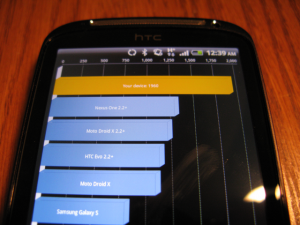
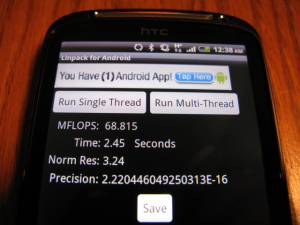
Benchmarks
Note: these benchmarks, as should all synthetic benchmarks, should be taken with a grain of salt, as they do not reflect real-world usage.
Quadrant Benchmark Suite: 1960
Linkpack multi-core: 61MFLOPS
Sunspider Javascript Benchmark: 6256ms
CF-Bench: 5135
In terms of results, the Sensation’s Quadrant results are significantly lower than the 3000+ of the Samsung Galaxy S II and even most Tegra2 results, though it must be noted that the Sensation is rendering 3D scenes in its native 960x540px resolution. A more accurate comparison would be between the Sensation and the Motorola Atrix, which runs at the same resolution with a Tegra2 SoC. The Atrix consistently scored over 2500 in Quadrant.
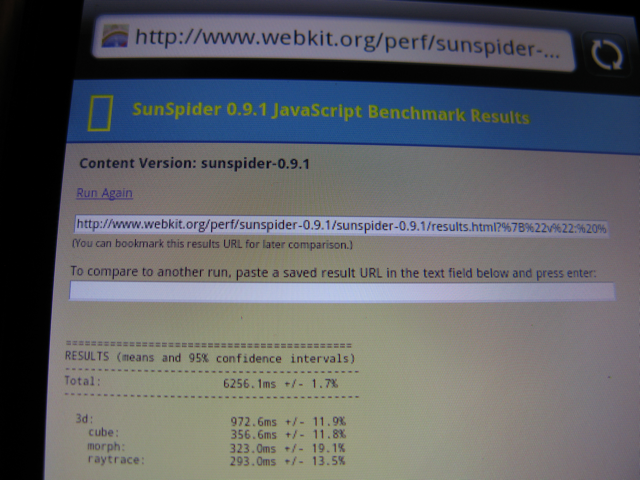
The Sensation also suffered handily at the hands of the Sunspider benchmark. Most newer devices, even last-gen single core processors such as the Incredible S, are able to complete the benchmark in just over 4000ms. Something is definitely wrong with the browser’s Javascript performance.
Camera
The HTC camera software has always been considered better than the sensor itself, but since the Incredible S and its various cousins, they have been making strides at image quality improvement. The 8MP sensor in the Sensation seems to be improved over previous generations, though the better results may be from increased processor performance than anything else.
The usual battery of settings are applicable: exposure, ISO, along with pre-set scenes such as Action or Close Up, which unfortunately replaces a dedicated macro mode. The device defaults to taking shots in widescreen, which is merely a cropped 4:3. A bit disingenuous, rather take the shot in full 8MP 4:3 resolution and crop it as you see fit.
Photo quality meets most phone standards, which is not to say it will win any awards, but given the right conditions nice results can occur. While very sensitive to movement, well-lit, stationary shots result in excellent colour saturation with minimal grain. The sensor re-focused quickly, and can be done by tapping anywhere on the screen. The dynamic focus actually works very capably.
Unfortunately there is no option to set exposure manually, so indoor scenes with artificial light often result in yellowish shots when White Balance is set to Auto. Changing to Fluorescent or Incandescent, depending on the type of light in the room, often got colours back on track, but resulting photos had too much grain to be useful.
HTC seems to be making an effort to improve their cameras, and indeed, make them a selling point, in their newly-announced myTouch 4G Slide for T-Mobile. Let’s hope its larger sensor and instant shooting technology make it into future devices.
The Sensation can take video at 1080p (1920×1088 to be exact), and it too has no trouble in good conditions. Capturing at 30fps, there is little ghosting and, when the phone is held steady, nary a hint of the shakiness so prevalent in mobile devices. This stability only extends so far, as the moment you attempt to re-adjust the focus while filming by tapping on the screen, it appears like a minor earthquake on film. There are several microphones on the Sensation, and the audio captured when shooting video is in stereo, though separation is difficult to quantify.
Be careful when first pressing Record that first time, though: the device defaults to taking video at its native qHD 960×540 resolution and must be manually changed to 1080p. As I’ll point out later, there isn’t much free space on the included microSD card, which probably led HTC to that decision.
As for the front-facing camera, well, it’s VGA, which means the quality is largely crummy. Strangely, it is a step down from the Incredible S, which has a 1.3MP front shooter. And because the Sensation is running Android 2.3.3 and not the newer 2.3.4, it isn’t possible to use video over GTalk like you can on the Nexus S. However, if video calling is your bag, there are a number of apps to fill in the gap, including Tango, ooVoo, Fring and Qik.
Battery Life
We’ve always tended to forgive HTC their shortcomings when it comes to battery life due to the intense work it takes to keep HTC Sense looking so good and running so smoothly. As Android as an operating system has come a long way since its inception, and various devices such as the Nexus S and Motorola Atrix have proven it is not impossible to attain good battery life.
The Sensation falls into the ‘it’ll do’ category: not great, but just good enough that I won’t deride HTC for failing its customers. With little to no activity on the device, it is possible to eek out two days from a single charge on the 1520mAh battery. But with any background tasks, including push email, background Twitter updates, moderate browsing and camera use, the device lasted until 8pm. It is understandable that the Sensation would be more power hungry than its single-core predecessors, but the moderate performance increase from the Incredible S does not warrant such a cut in battery life, especially since the Sensation is running updated software.
Keeping the display brightness low, and the actively killing errant background apps certainly helps, but the Sensation’s need for constant care is proof that Android needs tighter controls on what apps can run behind the scenes. Apps are allowed to run in the background even if they’ve never been opened.
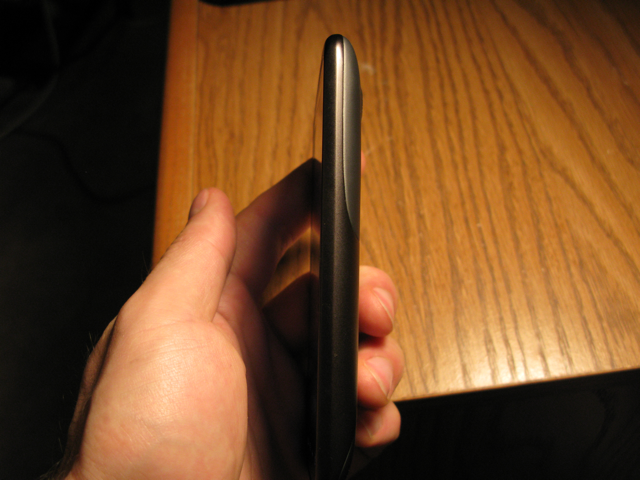
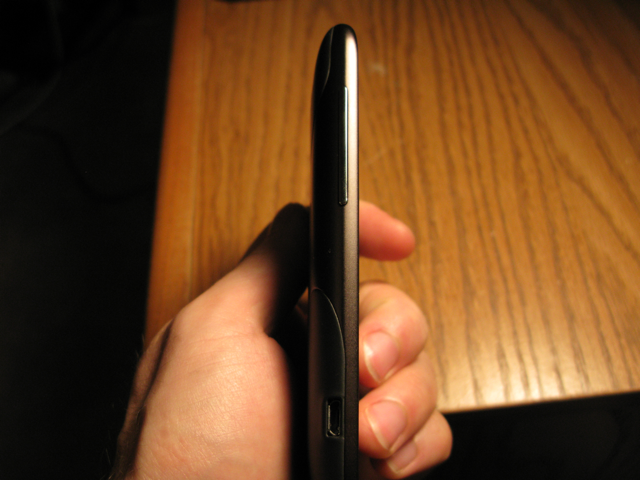
Call Quality and Network Speeds
Calls come through loud and clear. At this time I’d like to give a brief explanation on why Bell’s version of the Sensation is superior to the T-Mobile version released down south. You see, Bell’s network uses both the 850Mhz and 1900Mhz frequencies depending on attenuation (signal quality) and placement (not all areas have 850Mhz service). Lower frequency signals are able to travel better through obstacles, while higher frequency signals can travel further through the air. Unlike T-Mobile, or any AWS network (Wind/Mobilicity) networks with both a high and low operating frequency tend to have superior indoor signal levels, especially in places with thicker walls and in basements.
I had no issues in either type of environment obtaining a four- to five-bar signal, whereas an AWS device may only have one bar, if it had service at all. Voice calls rarely distorted, and I experienced no dropped calls on the Sensation. Those complaining of a “grip of death” similar to the iPhone 4 will find it largely depends on the level of signal available to the device, and in most parts of Canada this shouldn’t be an issue.
Data speeds were also excellent. I recorded the fastest speeds on the Sensation that I’ve ever seen on a Canadian device: 5.3Mbps download, 2.4Mbps upload with a 59ms ping time. The Sensation has theoretical maximum download/upload speeds of 14.4Mbps/5.76Mbps.
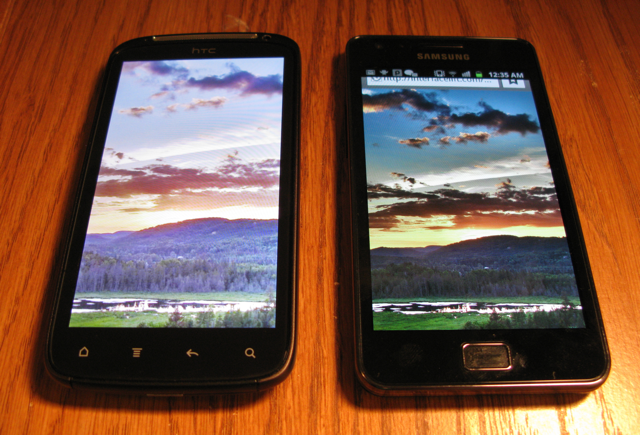
Sense Sensation
Sense 3.0 is not significantly different than its previous iterations. In fact, but for the 3D additions and the improved lock screen, it is largely unchanged.
When it was first released in 2009 on the HTC Hero, it provided an interface overhaul so exhaustive, so appreciated, that most Android users didn’t recognize it as the same operating system. But in 2011, when the Nexus S looks and feels about as fast as anything else on the market with specs almost a year old, it pains me to say that Sense may be losing some of the magic it once had.
There is something admirable about what HTC is attempting: to use Android as a launching pad for its own content and services. The device will sell you ringtones and themes. It has skinned its own mail, music, messaging and calendar apps (for the better) and its own browser, navigation and contacts app (for the worse). It bundles its own social networking widget in Friendstream, and its own Twitter app in Peep. There is a Flashlight app and a FM Radio. There is even a Dice app, for some reason (yes, you literally throw 3D dice around the screen). While many of these are austere replacements to native Google apps, some prefer to replace them with third-party alternatives from the Android Marketplace. But they do form a cohesive whole, and are comprehensive enough to be called a suite.
If you are partial to Sense, however, there is much to like. Like 2.1, Sense 3.0 shows recently-used apps in the notification bar, as well as an appreciated quick settings tab. Pinching anywhere on the homescreen shows a preview of each, though now press and hold and you can alter their location relative to one another.

There is helpful Dock Mode that displays, at a glance, the weather, the time along with your next two appointments. Behind is a gorgeous 3D animation of the current weather conditions.
The app drawer now displays five lines of apps, though they are paged as opposed to free-flowing like they were in Froyo. While it took me a while to get used to this method, it works better at identifying key apps. So too does the Frequent tab, which sorts apps in order of use.
The lock screen has also been updated for Sense 3.0, and is likely going to be the largest cause for celebration amongst loyal HTC fans. Six possible themes, each with its own widget above the four customizable icons, are available, including weather, stocks, photo frame, etc. The four icons, which launch practically any app installed on the device, are dragged into a little magnetic circle below. Perhaps most useful for the camera, phone, messaging and mail app (which are there by default) it is an awesome showcase of both the intuitive and evolutionary nature of HTC’s designers, and the somewhat limited improvements made to the OS as a whole.
A few odds and ends: when you plug the Sensation into a computer, a nice graphical depiction of your connectivity options pops up. You can mount the microSD card, or tether your data connection to your computer, or, if your computer has internet connectivity and your phone does not, you can use go the other way and use the device as a pass-through.
HTC Watch
HTC Watch is the Taiwanese company’s new media store. Movies can be rented for between $3.99 and $4.99, and purchased for $19.99. Rentals are for 48 hours, though once purchased you have up to 30 days to activate the rental. Rentals and purchases can be downloaded to the device for offline consumption, though be wary of having too many on the device at once.
Quality is top-notch, especially on the high-res screen, and if you want to try before you buy there are trailers available for each movie. Selection includes great movies (The Town, Inception) to the pulp (No Strings Attached, Paranormal Activity 2) and HTC hopes to expand its distribution reach with more content soon. There are 200 movies available at launch, with 300 more coming by the end of the month. The goal is to reach 2000 titles by year and. They even talk about adding “seasonal content,” hopefully replete with special pricing.
This is the first real content competitor to Apple’s iTunes released in Canada. While it doesn’t incorporate music, Watch is an attractive and easy-to-use service that shows how much care HTC is giving to their brand not only as a hardware manufacturer, but as a software provider. While there is no obligation to use the service, Watch is freely available for those who want it, and is certainly easier than ripping DVDs, encoding them and transferring them to your phone.
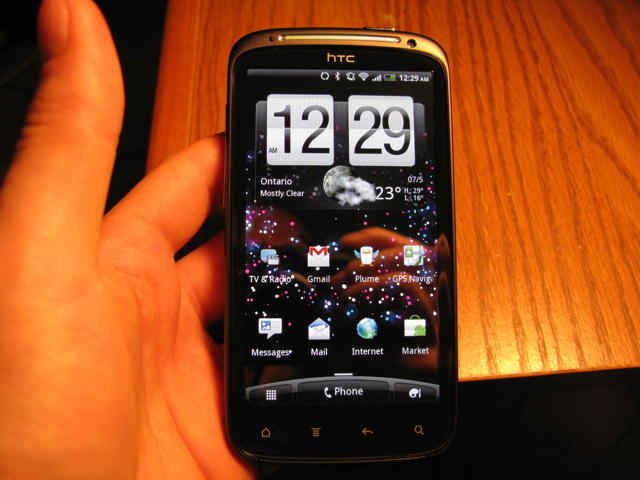
Bell Additions
As with most Bell smartphones, there are a few non-removable inclusions to the device. Mobile TV & Radio has morphed into quite a nice collection of live- and on-demand content from various Canadian providers for $5/month, though subscribing to every package can add up quickly.
Bell also has partnered with Gameloft to provide a portal for “HD” games, and bundles demos of N.O.V.A., a gorgeous looking Halo-like game, along with a virtualized Uno card game experience. Both are quality titles, but every time I tried to load Uno it crashed, and when I first launched N.O.V.A. it forced me to download 70MB in additional content. In addition, the portal leads to Gameloft’s mobile website, who will gladly charge you 30-40% more for the same game as on the Marketplace.
While not quite as odious as what Verizon bundles on their Android devices, we would like to see less bloat and more value from carriers. Android’s inherent customization should not be a free ticket for carriers and OEMs to clog up valuable app storage with non-functioning software.
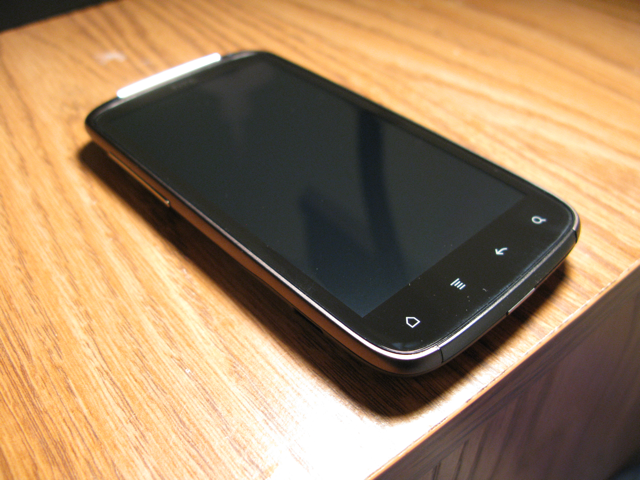
Wrap-Up
In many ways, the Sensation is HTC’s best phone. Not only their most solidly-constructed, it is one of the most attractive devices I can recall. Not only does the build quality surpass much of its competition, but it improves overall handling and portability. The phone is a joy to hold in the hand, with a few exceptions. Since the backing is made of metal, it gets quite hot, especially after taking photos or recording video. Since it’s the middle of summer the device felt dangerously hot after recording a couple minutes of footage outside on a warm day.
So too does the display come with compromises. Its increased pixel count is more than welcome, but the overall quality of the image seems to be inferior to the lower-density Super LCD screens used in the Incredible S/Desire S line.
And performance has also stepped up, though perhaps not as much as one would expect from such a spec jump. Benchmark results are quite a bit lower than comparable dual-core solutions, though synthetic results don’t usually translate into real-world performance. Running games optimized for high-res displays were smooth as butter, and, unlike previous HTC devices, I couldn’t get the keyboard to stutter, no matter how many apps were running in the background.
Sense is losing some of its lustre, despite how stable it has become. I couldn’t get an app to crash (except for the included game demos), but I’ve also grown used to making Android look the way I want it to. Sure, you can download an app launcher like Launcher Pro to replace HTC’s, but ultimately you’re playing their game. For fans of the overlay, though, it provides more of the same, which is a very good thing.
For Android newbies, this will be a huge benefit: tutorials and hand holding are the best way to introduce oneself to the often-intimidating world of Android, and HTC simplifies things to a forgiving level.
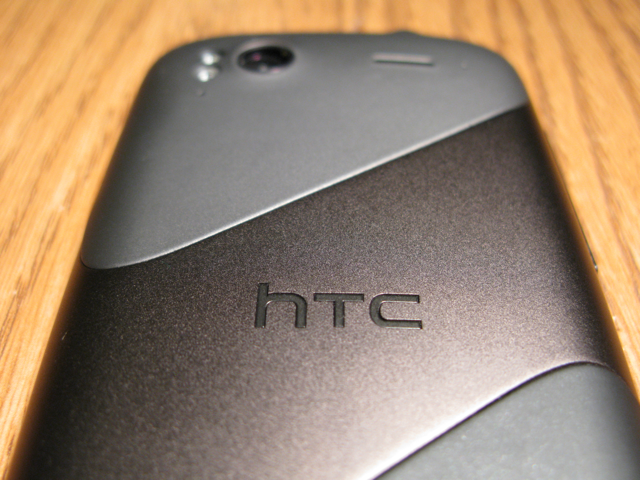
The Sensation is a powerful, attractive and stable Android device that provides access to a growing array of applications, widgets and customizations. No, the device isn’t hackable (yet), but should you decide to purchase it, do so knowing you’re mostly likely going to end up using the phone the way HTC wants you to. Sound familiar? There’s another company that’s attracting legions of customers by doing just that. And according to HTC’s latest earnings report, they’re profiting from such a tightening of focus.
The Bell HTC Sensation 4G is available for $149.95 on a 3-year term and $549.95 without a contract.
Rating: 8/10
Pros:
– Gorgeous form factor
– Best-in-class build quality
– High resolution display allows for more stuff and sharper text
– Excellent overall Android performance
– Good still camera and video quality
– Dual microUSB/HDMI port
– Very stable running Gingerbread
– Amazing data speeds and excellent call quality
– Lock screen shortcuts very useful (and attractive)
– Gorilla Glass display is bright and viewable in direct sunlight
Cons:
– Display has underwhelming viewing angles, colour reproduction
– Display is very reflective
– Battery life suffers from the dual-core chipset
– Sense overlay is getting long in the tooth, despite additions
– 3D effects are unnecessary and bog down the system
– Not (yet) hackable
– Only a VGA front facing camera
– 1GB internal storage for apps is not enough
—-
Update:
First of all, I didn’t mention a price, which is $149.95 on a 3-year term and $549.95 without a contract.
The compatible frequencies are 850/1900Mhz UMTS, which means it will have 3G connectivity on Bell, and when unlocked, Virgin Mobile, Rogers, Fido, Telus, Koodo, Sasktel and MTS (I think).
As for the Gingerbread CRT effect, it is not here, nor is it enabled in the Galaxy S II. This doesn’t mean it cannot support it, but rather HTC seems to have disabled it.
There is SIP (VoIP) support built in, so you can configure an internet phone. Obviously Google Voice does not work in Canada.
I took the comparison screenshot of the Sensation and Galaxy S II at a 45 degree angle to show the viewing angles. While the screen is much more vivid looking straight on, it still shows inaccurate colour reproduction compared to the Samsung. Doesn’t mean it’s not a great screen because it is.
In terms of hackability, someone has found an exploit that allows for temporary rooting of the device, but the root goes away once the system is reset. At this point no development can really happen on the device until a permanent rooting solution is found, which is still forthcoming. It took almost eight months for a permanent root solution to come to the Incredible S. Hopefully HTC will have unlocked the bootloader by then and prevent all this chaos.
Also, the guaranteed 18 months upgrade schedule proposed at Google IO has not been finalized yet, and therefore no carrier has given a commitment to upgrade any of their devices. I am assuming the Sensation will be upgraded to Ice Cream Sandwich when it is released in the Fall, but that’s not for me to speculate.
Overall, the more I’ve used the Sensation, the more I’ve enjoyed it.
MobileSyrup may earn a commission from purchases made via our links, which helps fund the journalism we provide free on our website. These links do not influence our editorial content. Support us here.

